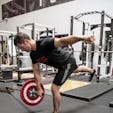The hex press¦ Sounds like a voodoo curse, right? So perhaps it’s a way to jinx training partners who are more swole than you¦ Actually, the hex press is a chest exercise that gets its name from the hexagon-shaped dumbbells it’s typically done with. Very simply, you press the weights into each other as you simultaneously press them over your chest (hexagonal dumbbells make this easier to do than round-plated ones, since they won’t slip as readily). The inward pressing creates a powerful squeezing sensation in the pecs, which is why the hex press is sometimes called a “squeeze press.”
The hex press feels intense, but it looks weird, and it seems to have only gained popularity in the past 10 to 15 years, so trainers have questioned whether the hex press is really a worthwhile exercise in a chest-training arsenal, or just another training fad that’s about to run its course. Lucky for you, we researched the move and got to the bottom of it, finding that it can be both a solid pec builder and a real help to those with shoulder problems that hamper their training.
How To Do The Hex Press Properly
The hex press takes a lot of concentration to perform correctly, but it’s technically very simple.
(See 02:55 in the video above)
Step 1. Lie back on a bench with a dumbbell in each hand and press the two weights into each other. They should meet in the middle of your breastbone, just over your chest. Arch your back, pushing your chest upward. The weights should be very close to your pecs—even touching—but not resting on your chest.
Step 2. Squeeze the weights together—hard—as you press them straight over your chest and lower back down again. Don’t let up on the tension—you have to keep the dumbbells in tight contact the whole time. That’s one rep.
It’s easier to get the weights to stay together comfortably—and without slipping—if you use hexagonal dumbbells, or another model of dumbbell that has flat sides and corners, but any dumbbells can work. (Note that if you do use round-plated dumbbells, your grip can slip while you’re pressing them together and one weight can end up mashing the fingers holding the other dumbbell, so be careful.)
“With the hex press,” says John Rusin, PT, a strength coach and founder of the Pain-Free Training Methods Certification (drjohnrusin.com), “you can knock out two different motions for the pecs at the same time—dynamic pressing, where you’re lifting the dumbbells from your chest to straight up in the air—and horizontal adduction, where you’re moving your arms toward your midline and holding an isometric contraction [that is, the weights don’t move horizontally but you’re tensing the muscles as if they were].” Essentially, you’re combining a dumbbell press and a flye exercise into one movement. That alone should be enough to classify the hex press as a good chest exercise, but wait, there’s more.
“The hex press limits the range of your pressing motion,” says Rusin. You’ll notice that, because your arms are pressing together the whole time, they won’t be able to lower as far on the downward portion of each rep, so you won’t get much of a stretch on the pecs in the bottom position, like you would if you were doing a regular dumbbell bench press. Normally, that’s not good, because muscles often grow better when they’re taken through full ranges of motion and forced to contract hard in a stretched position, but if you have shoulder pain, this reduced range may allow you to press again without irritation! Some chest pressing is better than no chest pressing, so if the hex press lets you carry on with your training, chalk that up as a win.
Furthermore, Rusin notes that pressing the weights together—maintaining that isometric contraction—“makes the rotator cuff and other stabilizer muscles in the shoulders more active. Herky jerky shoulders usually feel bad because the stabilizers aren’t working hard enough, and the hex press ensures that they will.”
One more benefit: the hex press requires maximum concentration to maintain the squeezing action while you press the dumbbells, and that means you’ll build a really strong mind-muscle connection in your training. You can’t zone out when you do this exercise, and research shows that focusing your mind squarely on the muscle you’re training may help to activate more muscle fibers and spur growth.
So that’s the classic, original dumbbell hex press, and while Rusin loves the concept, he doesn’t dig the execution.
The flaw he sees in hex pressing is that the forearms will tend to point inward as a result of the dumbbells being so close together. “If the forearms point inward,” he says, “you’re training an isometric in internal rotation under load. This won’t necessarily kill your shoulders, but it’s not ideal,” especially if you have pre-existing shoulder injuries. “The perfect position is with your forearms parallel to each other/perpendicular to the floor throughout the rep.” This is a much more natural way to press, but it’s difficult to do unless you’re using very heavy weights. You’ll typically need hexagonal dumbbells in excess of 50 pounds to allow your forearms to remain parallel while maintaining the squeezing motion (bigger dumbbells will cause the forearms to rotate outward further), and since the hex press takes a lot of energy combining movement in two planes, it doesn’t lend itself to going that heavy.
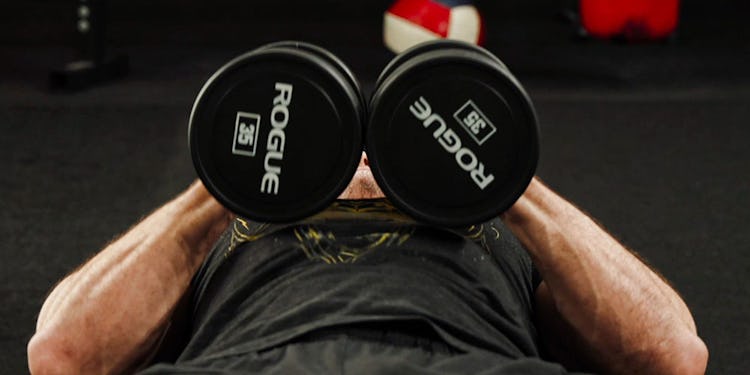
Enter the hex press with a medicine ball.
Placing a medicine ball on your lap and then squeezing it between the dumbbells will allow your forearms some space and will keep them more vertical, making for near-perfect pressing without sacrificing that isometric feature. This is the hex press variant Rusin recommends for most people, especially those who are new to the movement.
Hex Press With Medicine Ball
(See 01:57 in the video)
Step 1. Sit on the edge of a bench with a light medicine ball in your lap—six pounds or less is plenty. Hold a dumbbell in each hand and squeeze the ball in between the dumbbells. This should cause your forearms to be parallel, but if not, get a bigger ball until they’re closer to the ideal position.
Step 2. Now lie back on the bench with the ball and dumbbells at your chest. Arch your back and push your chest up. Squeeze the ball hard, and press the weights up to lockout. Continue squeezing as you lower back down.
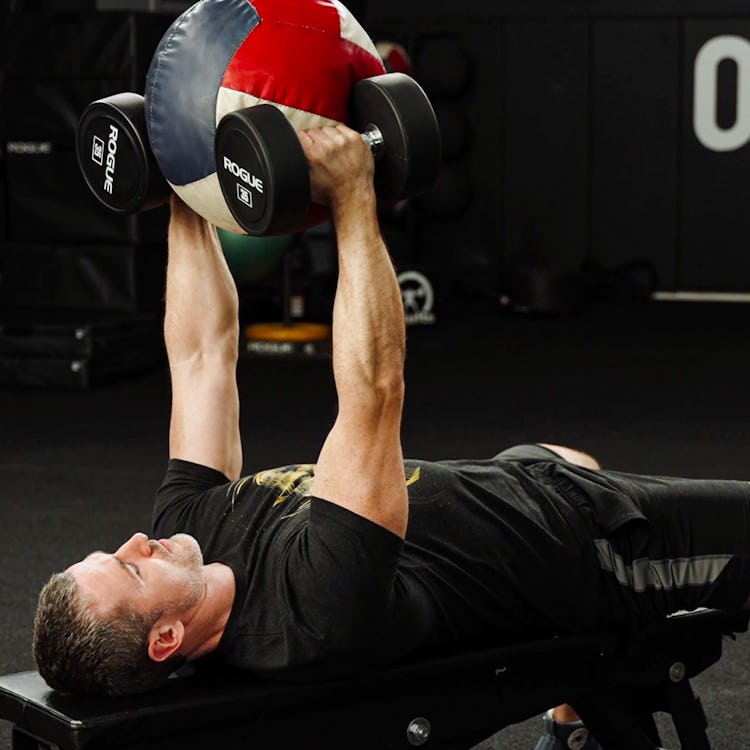
TRAINING TIP
Whether you choose the medicine ball version or the original, the hex press can be done in place of your normal dumbbell bench pressing whenever the latter aggravates your shoulders. It can also be a good choice for those who don’t feel their pecs working on conventional presses, in which case you might want to do it early in a session in order to warm up the chest and give it your best attention. Two to three sets of 8–12 reps are a good place to start.
If you’re just looking for a new pec exercise to experiment with, however, Rusin suggests using the hex toward the end of a chest or upper-body day to burn out the pecs. Go for the pump with higher reps, such as 15–25. Three to four sets is more than enough.
What Muscles Does The Hex Press Work?
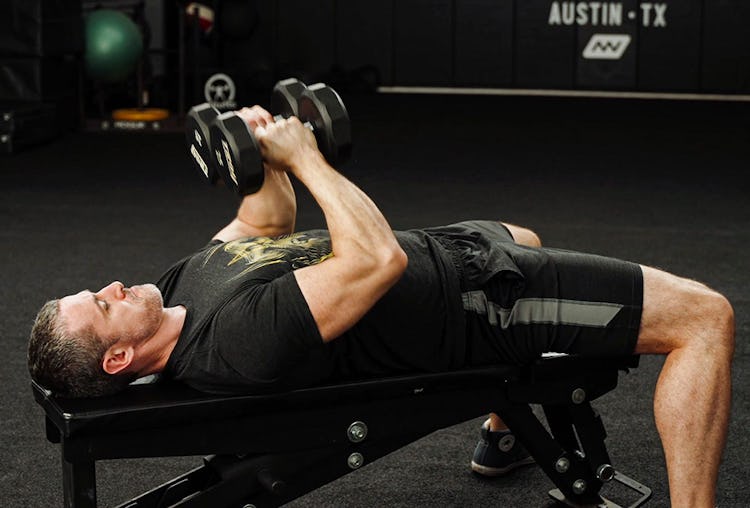
The hex press targets the pectoralis major, the main chest muscle you’ve been trying to build with more conventional bench press movements. Pressing the dumbbells together reduces the distance your arms can travel at the bottom of the range of motion (when the dumbbells are close to your chest), so the hex press won’t put the same stretch on your pecs that a regular dumbbell bench press would. But the squeezing action means that the contraction will be stronger at the opposite end of the range—at the top of the press, when the muscles are shortened. Therefore, it can be said that the hex press emphasizes the shortened position of the pecs more than other dumbbell presses, and that alone could provide a novel training stimulus.
Some coaches, and Rusin among them, believe that hex presses can produce more activation in the inner chest—where the sternal pec fibers (the ones that run horizontally across the middle of the pec major muscle) connect to the breastbone. This is a very controversial point, as most research shows that, while the pecs can be divided into upper, middle, and lower regions and trained to bring out one area over another, inner and outer divisions don’t exist. In other words, when you contract the sternal pecs, they share the tension from one end of the muscle to the other.
Nevertheless, muscle research is still in its infancy, and bodybuilders have proven it wrong in the past (scientists used to think the mind-muscle connection was sheep dip too). “I think we’re going to see the research catch up with what the bros have known for years,” says Rusin. “You can target and place more emphasis on different portions of the pec, and it’s highly dependent on mind-muscle connection.” So, if you do an exercise that helps you focus your mind on the innermost portion of your pec fibers, it’s not out of the question that they’ll grow as a result.
Because the shoulders and triceps work synergistically with the pecs in the hex press, you can count the hex press sets you do toward your total volume for those muscles groups as well.
Why And How To Do The Incline Hex Press
(See 03:47 in the video)
Performing any bench press motion on an incline can shift its emphasis to your upper chest, and the hex press is no exception. Incline pressing involves the shoulders to a greater extent, and that can irritate the joints, so the hex press done on an incline may be a way to get around otherwise painful incline pressing and still target the clavicular head of the pecs.
Step 1. Set an adjustable bench to a 30- to 45-degree incline and lie back with a dumbbell in each hand at chest level.
Step 2. Squeeze the weights together, and maintain the tension as you press the dumbbells up and come back down.
How To Stretch Before Doing The DB Hex Press
Warm up your shoulders and pec muscles, and lubricate your joints, before any workout that includes hex presses with this mobility sequence from former Onnit Chief Fitness Officer John Wolf (@coachjohnwolf). Do 3–5 sets of 3–5 reps for each movement.
Alternatives To The Hex Press
Some coaches argue that the hex press doesn’t work the chest as advertised because the tension from the adduction (the arms pushing inward) comes from your active squeezing, not from overcoming resistance in the horizontal plane. It’s the same, they say, as flexing any other muscle—sure, you can feel it working and maybe even burning, but it’s not being overloaded to produce gains.
This point is debatable, but if you’re an advanced lifter and want to make the hex press even more challenging, you can attach exercise bands to it. The tension of the bands will try to pull your arms apart, so you’ll have to work that much harder to hold the weights together, and that undoubtedly makes the hex press more like a hybrid press-cable flye movement.
Hex Press With Bands
(See 04:00 in the Pro’s Guide To The Dumbbell Hex Press video)
Step 1. Set up as you would for a normal hex press but attach bands to dumbbells on the floor, or some other sturdy objects. The bands should be set to where your hands will be when you lie back on the bench. Now hold the end of each band along with your dumbbells and lie back on the bench.
Step 2. Squeeze the dumbbells together, fighting through the band tension, and press them up.
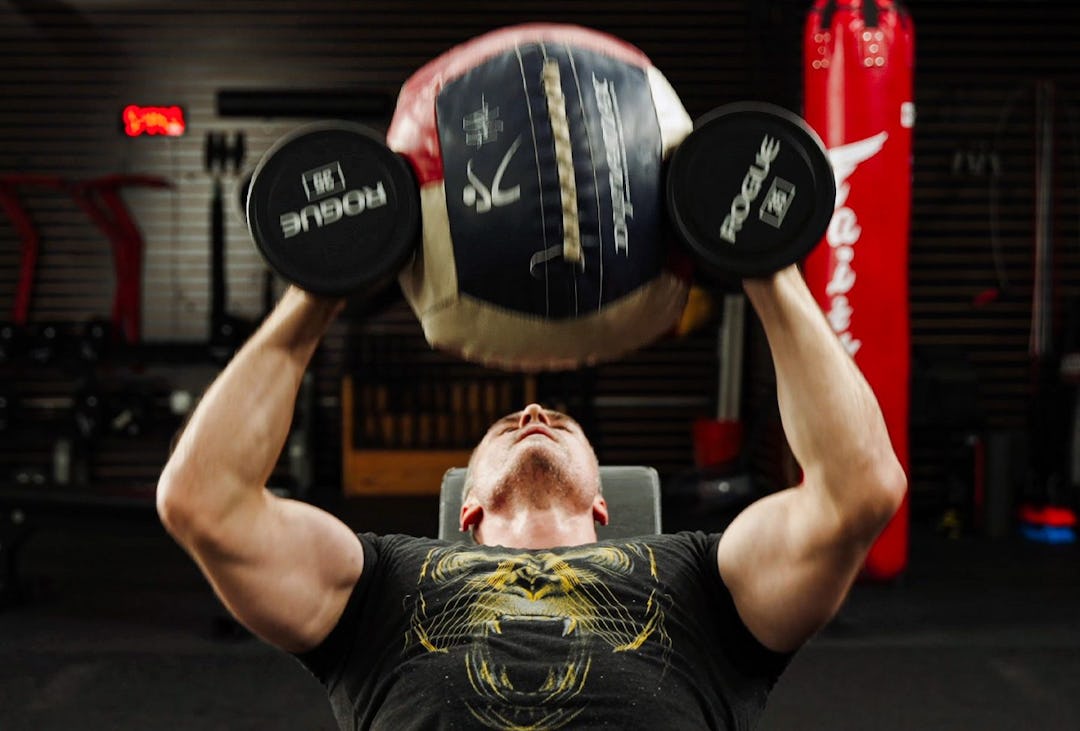
)

